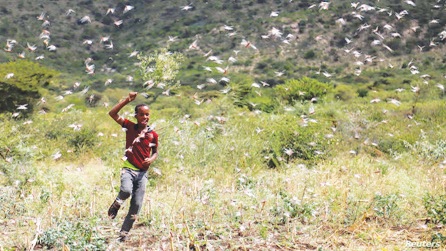
– Heavy rains contribute to crisis
ADDIS ABABA – Ethiopia, Kenya and Somalia are dealing with desert locust swarms of “unprecedented size and destructive potential” that could spill over into more countries in East Africa, the United Nations Food and Agriculture Organization (FAO) warned recently.
Destroying hundreds of thousands of acres of crops, the outbreak is impacting the region’s food insecurity.
The UN agency urged for a collective campaign to deal with the crisis, concerned over the risk that the swarms spill over into more countries in East Africa, “if efforts to deal with the voracious pest are not scaled up across the region”.
Recently, a new round of locust swarms has hit Ethiopia and is again threatening crops and food security, said agricultural officials.
Dereje Hirpha, Oromia State Head of Locust Control told the VOA that the new generation of locusts was first reported weeks ago in the Raya district and has since spread across thousands of hectares in 40 districts of the region.
The East African also reported virulent locusts, which have invaded parts of Kenya in the past three weeks, now have experts warning that their presence there and to the north of the country and now moving south and east, pose an unprecedented threat to food security and livelihoods in the Horn of Africa.
This new generation in Ethiopia is arriving from Somaliland, while breeding has continued on both sides of the Red Sea, and in Sudan and Eritrea, according to experts.
USAID plans to work with FAO to prevent and control the spread of locusts, its office of communication says. The agency is training more than 300 pest experts and providing 5,000 sets of protective equipment for locust fighters.
Dereje said authorities are spraying the affected areas from planes and vehicles on the ground to ward off the pests. Locals, meanwhile, are engaged in their own combat operation. When a locust swarm approaches, residents try to scare them away by blowing whistles, drumming empty buckets, setting fires, and shooting into the air.
“From a distance the swarm looks like a brown cloud, a sandstorm,” said Sora Kura, one of the chasers in the Borana zone.
The swarm follows the wind direction and is also guided by hairy antenna on their heads that detect smells and other signals of food, Dereje stated.
FAO said the swarms can move up to 150 kilometers per day and described it as the worst situation in 25 years.
USAID said the swarms will likely spread next to southwest Ethiopia and northwestern Kenya, and may enter Uganda and South Sudan.
The World Meteorological Organization (WMO) stated unusual weather and climate conditions, including widespread and heavy rains since October 2019, have contributed to a serious and widespread desert locust outbreak.
Forecasts of heavy rain, including forecasts of tropical cyclones making landfall in desert areas, from WMO members provide important information to National Locust Control Centers (NLCC) for their monitoring and control efforts.
Heavy rain triggers growth of vegetation in arid areas where desert locusts can then develop and reproduce.
In 2003 and 2005, locust outbreaks in more than 20 countries, mainly in North Africa, cost farmers 3.6 billion USD, according to the FAO.
The Ethiopian Herald January 23/2020
BY TSEGAYE TILAHUNE AND LAKACHEW ATINAFU





